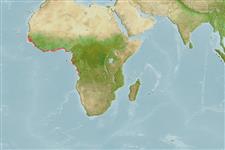>
Eupercaria/misc (Various families in series Eupercaria) >
Monodactylidae (Moonyfishes or fingerfishes)
Etymology: Monodactylus: Greek, monos = one + Greek, daktylos = finger (Ref. 45335).
Eponymy: Albertus Seba (1665–1736) was a very wealthy Dutch apothecary, zoologist and natural history collector, who published a lavish series of illustrations depicting, in part, marine life of the Indo-Pacific. [...] (Ref. 128868), visit book page.
More on author: Cuvier.
Environment: milieu / climate zone / djupintervall / distribution range
Ekologi
marina; sötvatten; brackvatten pelagic-neritic. Tropical; 24°C - 28°C (Ref. 2060); 16°N - 17°S, 25°W - 14°E
Eastern Atlantic: west African coast, from Cape Verde to Angola (Ref. 81286, 81657), including the Canary Islands (Ref. 7314, 81657) and Senegal (Ref. 28587, 81657).
Length at first maturity / Size / Vikt / Age
Könsmognad: Lm 8.0 range ? - ? cm
Max length : 25.0 cm TL hane/ej könsbestämd; (Ref. 2683); common length : 15.0 cm TL hane/ej könsbestämd; (Ref. 2683)
Short description
Bestämningsnycklar | Morfologi | Morfometri
Taggstrålar i ryggfenan (totalt) : 7 - 8; Mjukstrålar i ryggfenan (totalt) : 32 - 38; Taggstrålar i analfenan: 3; Mjukstrålar i analfenan: 36 - 38. Diagnosis: body very deep (depth greater than body length) and strongly compressed, its anterior profile very steep; head small; eyes large (Ref. 81286, 81657). Mouth small, oblique (Ref. 81286, 81657), maxilla extending beyond level of anterior eye (Ref. 81286). Jaws with villiform teeth; granular teeth present on roof of mouth and tongue (Ref. 81286). Preopercle smooth or with minute serrations; 1st gill arch with 22-27/1/7-11 (total 31-37) gill rakers (Ref. 81657). Dorsal and anal fins triangular (Ref. 81657), long-based and very high anteriorly (Ref. 81286, 81657). Only tip of dorsal fin spines visible (Ref. 81286, 81657). Pectoral fins short; pelvic fins present in young individuals, rudimentary or absent in adults (Ref. 81286). Scales covering all of body, head and bases of dorsal and anal fins (Ref. 81286, 81657). About 50 tubed scales in lateral line (Ref. 81286). Caudal fin slightly emarginated (Ref. 81657).
Coloration: silvery grey/brownish (Ref. 81286, 81657), somewhat darker dorsally (Ref. 81657), with 4 dark brownish-black/soot-coloured vertical bars, more distinct in young individuals (Ref. 81286, 81657) and already fading or almost absent at >50 mm SL (Ref. 81657), 1st at level of eye, 2nd between dorsal- and anal-fin origins, 3rd between tips of these fins, and 4th on caudal peduncle (Ref. 81286, 81657). In adults, dorsal and anal fin tips, basal part of dorsal and anal fins and hind caudal edge blackish; dorsal and anal fin edge and basal part of caudal fin pale; pectoral fins smoky grey to white or even transparent (Ref. 81657).
Body shape (shape guide): short and / or deep; Cross section: compressed.
Very common in estuaries and lagoons (Ref. 2683, 81286, 81657) where reproduction takes place, marshes and lower courses of rivers, sometimes ascending over long distances into freshwater (Ref. 81286, 81657). Also lives in the sea, mainly in shallow bays and harbour areas (Ref. 81286). Sometimes found in shoals composed of several hundred individuals (Ref. 81657). Feeds on fish, shrimps, zooplankton (Ref. 28587, 81657) and various small invertebrates (Ref. 81657). Neither anterolateral glandular groove nor venom gland is present (Ref. 57406). Maximum reported standard length 200 mm (Ref. 81657).
Life cycle and mating behavior
Könsmognad | Reproduktion | Lek | Ägg | Fecundity | Larver
Distinct pairing (Ref. 205). After a stormy courtship a female lays 15,000 or more eggs which hatch in 24 hours (Ref. 7020).
Bauchot, M.L., 2003. Monodactylidae. p. 512-513. In D. Paugy, C. Lévêque and G.G Teugels (eds.) The fresh and brackish water fishes of West Africa Volume 2. Coll. faune et flore tropicales 40. Institut de recherche de développement, Paris, France, Muséum national d'histoire naturelle, Paris, France and Musée royal de l'Afrique Central, Tervuren, Belgium, 815p. (Ref. 81286)
IUCN Red List Status (Ref. 130435: Version 2025-1)
Threat to humans
Harmless
Human uses
Fiskeri: mindre kommeriell; Akvarium: Kommersiell
Verktyg
Special reports
Download XML
Internet-källor
Estimates based on models
Preferred temperature (Ref.
123201): 24.4 - 27.9, mean 27.2 °C (based on 22 cells).
Phylogenetic diversity index (Ref.
82804): PD
50 = 0.6250 [Uniqueness, from 0.5 = low to 2.0 = high].
Bayesian length-weight: a=0.02188 (0.01350 - 0.03546), b=3.02 (2.88 - 3.16), in cm total length, based on LWR estimates for this species & (Sub)family-body (Ref.
93245).
Trofisk nivå (Ref.
69278): 3.9 ±0.64 se; based on food items.
Fishing Vulnerability (Ref.
59153): Low vulnerability (15 of 100).
🛈
Nutrients (Ref.
124155): Calcium = 167 [87, 313] mg/100g; Iron = 1.38 [0.81, 2.51] mg/100g; Protein = 18.5 [17.4, 19.6] %; Omega3 = 0.196 [0.099, 0.365] g/100g; Selenium = 24.4 [11.0, 53.2] μg/100g; VitaminA = 35 [11, 110] μg/100g; Zinc = 1.35 [0.87, 2.01] mg/100g (wet weight);
